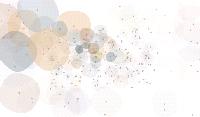
Nodes of dissident hues are randomly arranged within a stage divided into two equal areas. The inner area clusters nodes closely, and keeps their size small. The surrounding area distributes nodes further apart and allows larger sizes. Each generating cycle produces exactly 242 nodes. |
||||
|
||||
 figure B. nodes of color lose their transparency through interaction |
||||
I enjoy this particular module because of the watercolor-like effects produced in the early stages of interaction. New colors appear in areas where nodes overlap each other. |
||||
 figure
C. these nodes have been thouroughly
worked over by the mouse, evidenced by the high degree of opacity figure
C. these nodes have been thouroughly
worked over by the mouse, evidenced by the high degree of opacity |
||||
|
None of this would not be possible without Flash's exceptional handling of the alpha channel. Much respect to Macromedia's development staff for the incredible accuracy and speed with which pixel color and transparency values are calculated. A musician friend of mine calls human accomplishment of this magnitude 'complete synapse'. Just what exactly is in San Francisco's drinking water, anyway? |
||||
jtarbell september 29, 2001 |



